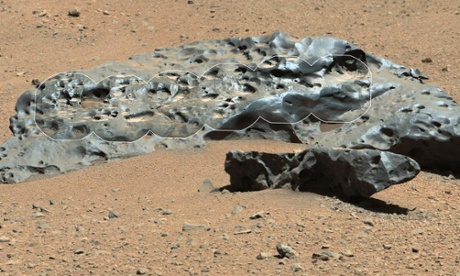The iron meteorite discovered by the Curiosity rover must once have been at the heart of a growing planet that was shattered aeons ago.
Meteorites like the one discovered by Curiosity are time capsules – often the fragments of doomed worlds from the beginning of our solar system. Photograph: Nasa/JPL-Caltech
The meteorite is made of iron and about 2 metres long, which is about the width of the Nasa rover that found it. It is the first meteorite that Curiosity has found on Mars. Scientists have named it Lebanon – presumably because of its shape.
Meteorites are lumps of rock and metal that fall from space and impact the surface of a planet. They are time capsules, usually representing the shattered fragments of doomed worlds from the beginning of our solar system.
Around 4.6bn years ago, the sun and planets of our solar system began to form. This involved the collision of various rocks and asteroids that melted together and gradually built the Earth, Mars and the other planets. Astronomers call this process "hot accretion". With the planets being molten, the heavy metals such as iron would sink towards the centre of each planet, while the lighter rocks would float to the surface and cool into the landforms.
As the planets grew in size, however, so the collisions between them tended to become more violent. Sometimes, the nascent worlds would be shattered rather than melted together. Iron meteorites come from the deep, core regions of these doomed planets.
According to the Nasa statement that accompanied the image, the cavities visible on this meteorite may once have been filled with olivine minerals. If so, that could indicate it hailed from a place near the core-mantle boundary in its parent world. This was where the iron core gave way to the rocks and minerals of the mantle region.
Although this is the first meteorite found by Curiosity, its predecessor rovers Spirit and Opportunity both found numerous smaller examples. The first meteorite on Mars was discovered by Opportunity in 2005, close to its landing site at Meridiani Planum. That too was an iron meteorite.
Meteorites may be common on Mars because there is very little atmosphere to weather them away. On Earth, meteorites survive for a few million years before being eroded away. On Mars, the weathering rate is probably a thousand times slower, so meteorites could last for billions of years. They would accumulate on the surface of the planet like flies on fly-paper.
A study performed by Bland and Smith in 2000 estimated that there could be between 500 and 500,000 meteorites with a mass greater than 10 grams for every square kilometre of Mars.
A meteorite geologist on Mars would have a field day. He or she could use this collection to check for changes in the flux of meteorites over the ages, or look for rare compositions. It is possible that meteorites blasted from the Earth’s surface could be lying on Mars, just as pieces of Mars have been found as meteorites on Earth.
Curiosity is almost two years into its mission. It is still en route to Mount Sharp, the shallow mountain it will attempt to ascend. Progress has been much slower than anticipated. Partly this is because the mission's geologists keep wanting to stop and investigate interesting looking rocks. And partly because the wheels of the rover are showing more damage that anyone expected.
It seems it's tough going when you off-road on Mars. But discoveries such as this meteorite make the journey as well as the destination worthwhile.
Stuart Clark is the author of Is there Life on Mars? (Quercus). Follow him on twitter as @DrStuClark
Source: .theguardian.com


Sem comentários:
Enviar um comentário